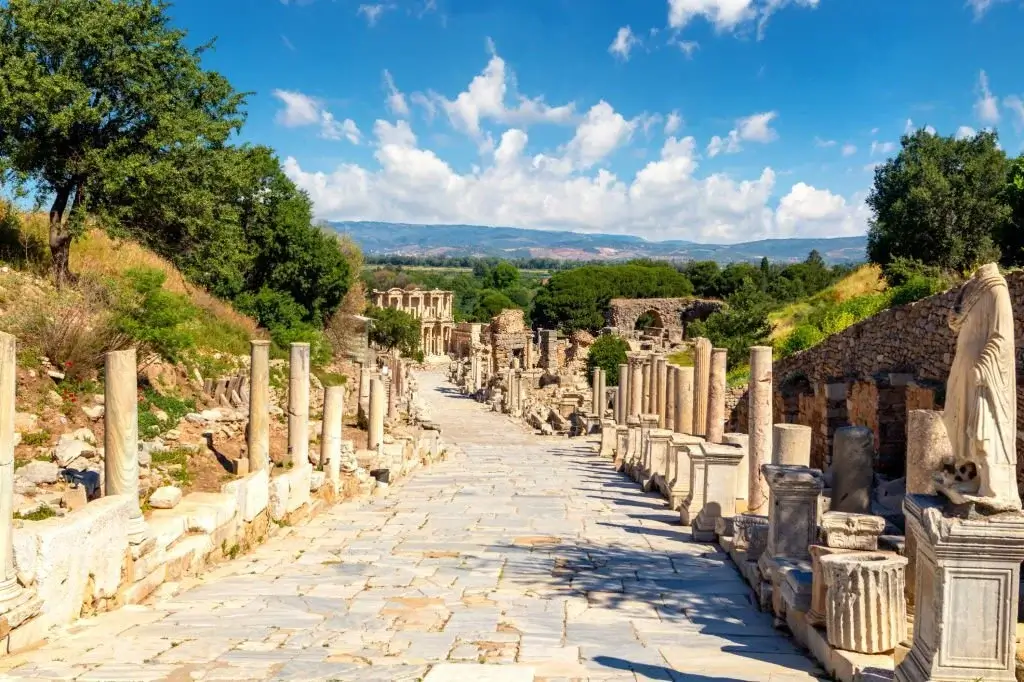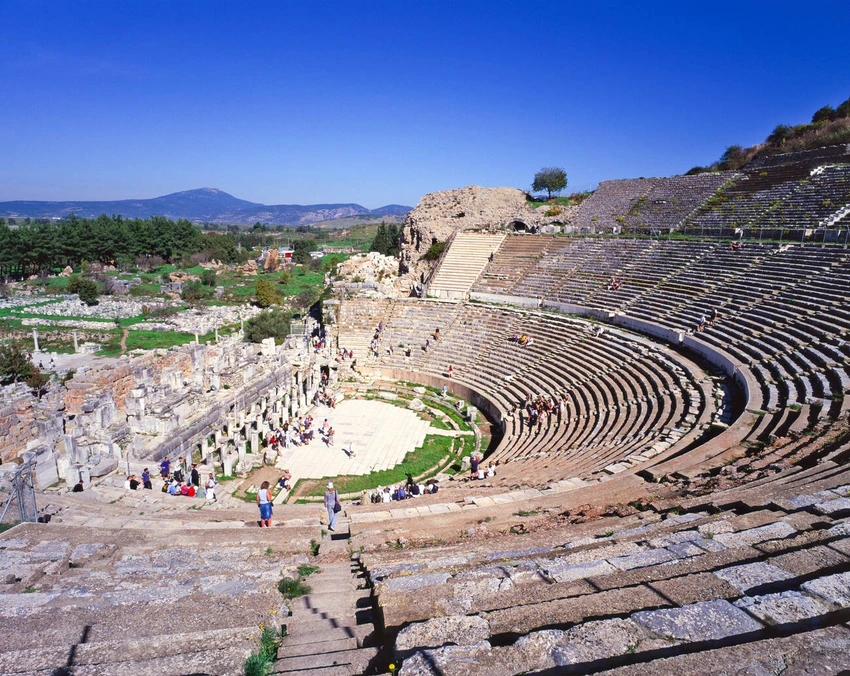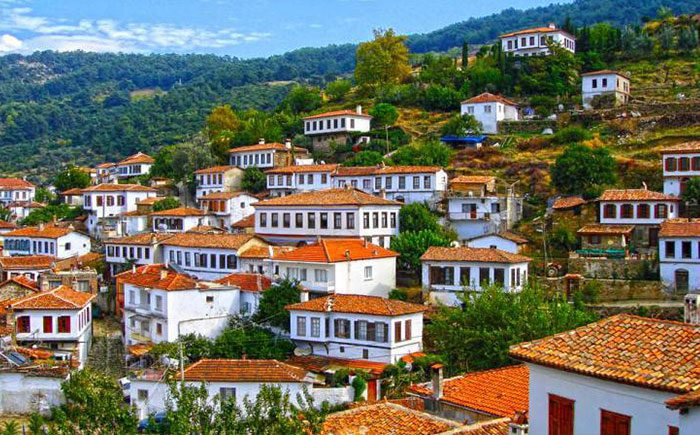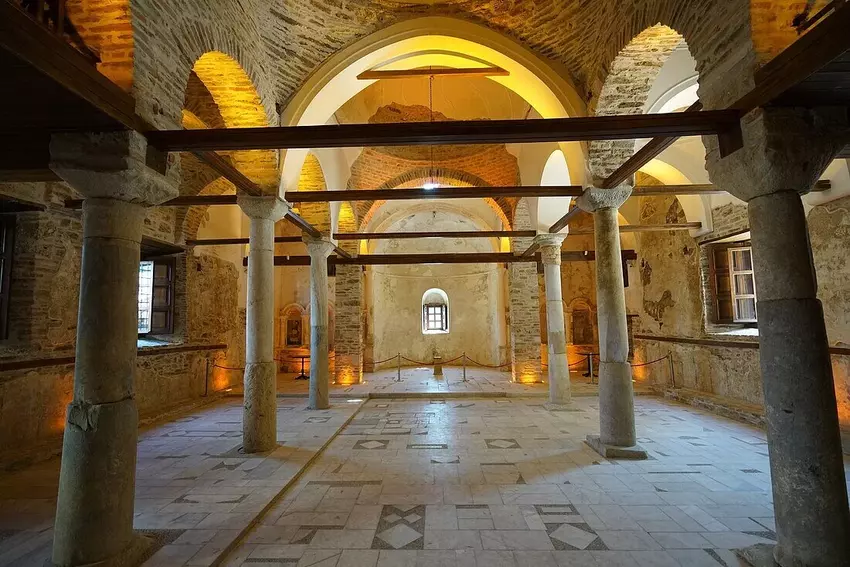For planning a day to Selcuk, Ephesus Historical zone from Kusadasi Port, Izmir, or Istanbul, the tips below can give you an idea to tailor a program for yourself.
Table of contents
- What do I need to know before going to Ephesus?
- 1)- Ephesus Ancient City (approx. 1,5-2 hours required)
- 2)- The Temple of Artemis (approx 25 min required)
- 3)- The Basilica of St. John (approx 40 min required)
- 4)- The House of the Virgin Mary (approx 45 min required)
- 5)- Ephesus Archaeological Museum (approx 1 hour required)
- 6)- Sirince Village
What do I need to know before going to Ephesus?

Where is Ephesus?
The modern name of Ephesus is Selcuk. Selcuk is a town with a population of 36,000 in the Aegean region (Western Part) of Turkey. So Ephesus Ancient City is located in Selcuk, between Aydin and Izmir cities (Symrna). Ephesus was once a major center of commerce and trade, but it is now one of the most popular tourist attractions. Selcuk is 60 km south of Izmir and 18 km from Kusadasi Cruise Port.

What is Ephesus famous for?
The area has been divided into five different sections; those features in and around Selcuk including the Ephesus Ancient City, the Temple of Artemis at Ephesus, the House of the Virgin Mary, Basilica of St John, Ephesus Archaeological Museum (the museum where you can see the artifacts found in the excavations of the ancient city Ephesus).

Can I tour Ephesus on my own?
Yes, you can tour the ancient city of Ephesus on your own. Also, you have a chance to buy the audio guide selling at the entrances. But remember that no one knows the history of Ephesus better than a local tour guide. You can visit our tour pages for our private Ephesus tours with local guides.

Does Ephesus have a dress code?
No, there is no dress code for the ancient city of Ephesus. However, we recommend that you wear comfortable clothes and have a hat, water, and sunscreen with you during the hot summer months.
Is Ephesus Open every day?
Yes, the ancient city of Ephesus is open every day. Closing hours differ in winter and summer periods. In winter, opening and closing times are 08:30-18:00, however, in summer the closing time is 19:30.
What is the entrance fee for Ephesus?
Until the end of March 2023, the entrance fee to the ancient city of Ephesus is 200 Turkish Lira per person (10 Euros). However, as of April 1, 2023, it will be 400 Turkish Lira per person (20 Euros). If you have a disabled guest, you can get 2 free tickets.
Is “Best Ephesus Tours” Organizing Tours to Ephesus?
Yes! Our specialty is the organizing of private Ephesus tours and Ephesus Shore Excursions from Kusadasi, Izmir, and Istanbul. You can take a look at the tour pages at the links below and get detailed information.
Ephesus Tours From Kusadasi
Ephesus Tours from Izmir
Ephesus Day Trip from Istanbul
Pamukkale and Ephesus Day Trip
Is one day enough for Ephesus?
The average visit time to the ancient city of Ephesus is 2 hours. This period varies according to your interests and preferences. If you spend 1.5-2 hours in Ephesus Ancient City, you will have the opportunity to see other places in the historical region of Ephesus, and one day might be enough to visit the whole region.

Below you can find the details of these five different sites and historical spots including the approximate time recommended to spend. You may schedule your time according to your interest and plan a day for yourself. Or easily get in touch with the sales team of Best Ephesus Tours to help you with your tour plan.
1)- Ephesus Ancient City (approx. 1,5-2 hours required)
Although structures dating from the Imperial Roman period dominate the Ephesus landscape, the area contains remnants of other occupational periods. The Gymnasium of Vedius and the stadium in the Acropolis and a small temple dating from the Ionian period.

A major feature of the Hellenistic period is the section of the wall following the crest of Bulbul Dagi and on the east slope of Panayir Dagi. The plan of the city as it now stands probably dates to a large degree to the Hellenistic city of Lysimachus, though most of the buildings were remodeled during the later periods. The decline of Ephesus is exemplified by activities during the Byzantine period. A new city wall was built from the crest of Panayir Dagi to the port area encircling the Byzantine city.

A few new structures, the most important of which was the Church of the Virgin Mary were built near the old port. On the east flank of Panayir Dagi is the impressive necropolis associated with the famous Seven Sleepers of Ephesus which is pure of the Christian era. The abandonment of Ephesus was during the Byzantine period.
What are the important features of the city of Ephesus?

Bouleuterion or Odeion
The semi-circular theatre built on the north slope of Mount Pion had a 1400 seating capacity. 150 AD constructed theater used as a bouleuterion “a meeting hall for city council”.

State Agora
State Agora is located in the upper part of the city and is thought to be used mostly by the wealthy population of the city mostly for political meetings and discussions but not for commercial purposes. In the middle of the state agora, surrounded by stoas on three sides, a temple dedicated to Isis is located.

Domitian Temple
The temple of Domitian was built in honor of the emperor Domitian in the 1st century AD and destroyed after the rise of Christianity in the 4th century AD. After the death of the unpopular emperor, the temple changed to the name of his father, Emperor Vespian. Domitian was known as anti-christian, because of his persecution of Christians and exile of St. John to Patmos.

Curetes Street
Starting from the Gate of Hercules way down to Celsus Library one of the main streets of ancient Ephesus is called Curetes Street. The word Curetes means the legendary heroic people who took part in the quarrel against the Calydonian boar. The name is also used to refer to a group of priests in Ephesus. The side of the street is full of fancy shops with well-decorated mosaics on the ground.

The Gate of Hercules
The word “Pillars of Hercules” is an ancient name that refers to the hills at the eastern entrance of Gibraltar Straight separating two continents Africa and Europe. Hereby this ancient name was used in Ephesus ancient city to refer to the gate separating commercial and administration parts of the city. At the top entrance of Curetes Street replaced pillars have Hercules sculptures on them, holding the head of Namea Lion. Slaying the lion was the first task of Hercules and this carving at the entrance of the distinguished people part may be a warning sign for those who have no good intentions entering the administrative part.

Temple of Hadrian
The temple of Hadrian has been an official cult temple of the emperor Hadrian. It is known that the emperor visited Ephesus at least two times between 129 – 131 AD. As a return for his visits, Ephesians honored the emperor with the title of “founder and savior”. Although its small dimensions Hadrian Temple consist most attractive structures.

Trajan Fountain
The fountain of Trajan was constructed in the 2nd century in the honor of Emperor Trajan. Considered as one of the best fountains in the city consists of Composite and Corinthian-style capital columns together with statues of Dionysos and Aphrodite. The largest statue of Nymphaeum was the statue of Emperor Trajan replaced in the middle of the pool above the water channel. There is a marble ball symbolizing the world under the feet of the statue. And an inscription at the base states that; the world rested under the feet of the emperor.

Latrines of Ephesus
The Roman latrines in Ephesus were constructed in the 1st century AD over a channel with uninterrupted water. Latrines were the public toilets of the city for those who can not afford a toilet in their homes but public Latrinas required admission fees. Similar to Roman culture, Latrinas in Ephesus served for social purposes as baths. Besides the nature usage as toilets, Latrines were the places where citizens discuss politics and daily concerns.

Ephesus Brothel
Located at the bottom end of Curetes Street opposite of the Celsus Library so-called Ephesus Brothel is dating back to the 1st century AD. The statue of Priapus and the mosaic on the ground of the west side room, detail two women and a man having fun together are strong evidence of the house of pleasure.
Foot Sign of Ephesus Brothel

Also one of the first advertisements of the ancient world carved on the pavement of Marble Street shows the direction of the love house pointing at the same location.

Celsus Library
Celsus Library is the only remaining example of a giant library of the ancient world. 2nd century AD constructed a library believed to have over 12000 scrolls. Celsus was a romanized greek person and one of the first governors of Rome in Ephesus. The Library of Celsus was commissioned by his son Aquila as a funerary monument in the era of Hadrian. The female statues are personifications of Celsus’s character; Sophia (wisdom), Episteme (knowledge), Ennoia (intelligence), and Arete (excellence).

Grand Theater of Ephesus
25000 seated capacity Grand Theater of Ephesus remodeled version of Hellenistic theater in the time of Lysimacos around 250 BC. Today accepted as one of the best preserved Greco-Roman architectural examples of the ancient world. It is also the highlight of biblical tours as it is where the riot against St. Paul processed by Demetrius held.

Harbour Street
500 meters long Harbour Street so-called Arcadiane Street is dating back to the Hellenistic period connecting the Harbour of Ephesus to the Grand Theater. The street was the first place where the guest first arrive and walked along. The Street designed to reflect the commercial wealth of Ephesus had two walkways on both sides.
2)- The Temple of Artemis (approx 25 min required)
The Temple of Artemis at Ephesus was built in 550 BC by the Lydian king Croesus. Ephesians rebuilt the temple burned down by a Greek citizen willing to immortalize his name called Herostratus in 356 BC. This last version of the temple with 127 columns survived for 600 years and was listed as one of the seven wonders of the ancient world by Herodotus. The English architect John Turtle Wood discovered the destroyed temple in 1869. Manage to recover some sculptured pieces and shipped them to London. Today, there is a gallery in the British Museum where pieces from the Temple of Artemis at Ephesus are exhibited. It is also known as the location of Artemission where the second ancient city of Ephesus was.

The historical area of Artemission is situated in Selcuk. There are also structures dating back to the Byzantine era and continue to Selcuk Turk, Ottoman, and Turkish Republic periods in the same historical zone. But the Artemision represents a monumental feature worthy of individual treatment.

Although the oldest temple of Artemis was built here during the Ionian period, legends refer to this site as the sanctuary of the Anatolian Mother Goddess Cybele. Destroyed many times, the temple was rebuilt on a grander scale each time, reaching its climax during Hellenistic times when it was rated one of the Seven Wonders of the World. A part of the Artemision is the Sacred Way, originally a covered street, stretching from the Magnesian Gate around the eastern flank of Panayir Dagi to the sanctuary.
3)- The Basilica of St. John (approx 40 min required)
The Basilica of St. John, a center of pilgrimages during the Middle Ages, was converted to a mosque by the Selcuks. Reduced to use as a warehouse, it was later destroyed by an earthquake. The hill on which the Church of St. John is located was the site of the walled city occupied after the abandonment of Ephesus.

The impressive Persecution Gate is all that remains of the city wall. Topping the hill is the fortified citadel built as a final retreat for the Christians during the Muslim incursions. The citadel was later restored and used by the Selcuk Turks.

Scattered throughout the village are mosques, mescits, baths, and tombs of the Selcuk period. The most impressive of these structures is the mosque of Isa Bey below the Church of St. John.
4)- The House of the Virgin Mary (approx 45 min required)
The House of the Virgin Mary is located within the boundaries of the park, the site is owned and administered by a French religious order on the top of Bulbul Mountain.

Based on a common Christian theory Mary came to Ephesus together with St. John. There was no written history regarding the exact location in or out of Ephesus. The current location of the house of the Virgin Mary discovers by following the clues and the descriptions of the German nun, Anna Catherina Emerich.
5)- Ephesus Archaeological Museum (approx 1 hour required)
In 1964 founded Ephesus Archaeological Museum is where you can see the findings from the excavations of the Ephesus archeological site. Although there are many artifacts transported to London and Vinea by British and Austrian archeologists, the museum still houses many finds discovered after the establishment of the Turkish Republic.
Sculptures from the major fountains of Ephesus, numerous coins from different eras, findings from the Houses of Riches, a Courtyard with capitals and tombs, the Hall of Artemis and Mother Goddess of Anatolia are some of the main galleries and exhibits you can see in the museum.
Click here to read our detailed article about Ephesus Archaeological Museum
6)- Sirince Village
Sirince Village is a hidden jewel, providing a unique fusion of antiquity, civilization, and environment.

The History of Sirince Village
Sirince Village has a history, dating back to the ancient Greeks. The village was primarily established by the Ionians in the 5th century BC and was subsequently inhabited by the Romans, Byzantines, and Ottomans. Today, Sirince Village stands as a well-preserved example of a Greek-era structure, with many traditional houses, chapels, and churches still intact.

How to Get to Sirince Village
Sirince Village is located approximately 8 km east of the town of Selcuk and approximately 20 km to Kusadasi. The easiest way to arrive in Sirince Village is by car, but it is also feasible to take a local bus from Selcuk or Izmir. If you’re traveling from Istanbul, you can take a flight to Izmir, and then lease a car or board a bus to Sirince Village.
Top Tourist Attractions in Sirince Village

a) Saint John the Baptist Church
Saint John the Baptist Church is one of the most well-known landmarks in Sirince Village. The church was constructed in the 19th century and is renowned for its beautiful frescoes and intricate structure. Presently, the church is utilized as a cultural center and is open to visitors.

Sirince Grand Bazaar
The Sirince Bazaar is a must-visit place in the village. The bazaar is located in the center of the village and is home to a comprehensive variety of stalls retailing native handicrafts, souvenirs, and traditional victuals. Also, don’t forget to taste delicious Turkish coffee in Sirince Bazaar.

Sirince Vineyards
Sirince is famous for its vineyards, which produce one of the best wines in Turkey. Visitors can embark on a tour of the vineyards and enjoy a tasting of the local wines.
Sirince Village Mosque
The Sirince Village Mosque is an exquisite example of Ottoman-era architecture. The mosque was built in the 19th century and is famous for its intricate tile work and embellished ornamentation.

Where to Stay in Sirince Village
Sirince Village provides an array of accommodation alternatives, including traditional guesthouses and boutique hotels. Some of the most admired options include the Sirince Houses, the Nisanyan Hotel, and the Gullu Konaklari.
Is Sirince Village worth visiting?
Yes, Of course, Sirince Village is worth visiting. It provides a unique blend of antiquity, civilization, and environment, and is home to some of the most resplendent architecture in Turkey.
Is Best Ephesus Tours Organizes Tours to Sirince?
Yes, you can take a look at our Ephesus and Sirince Village tours from Izmir and Kusadasi below, or you can request a tailor-made tour.






